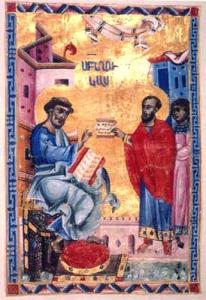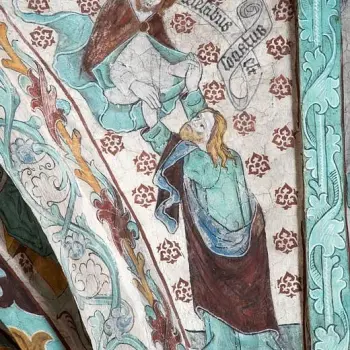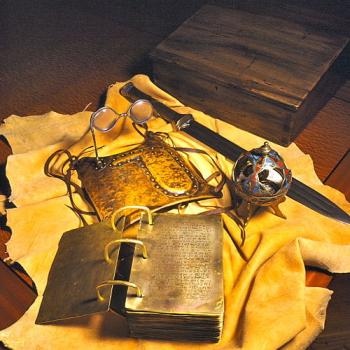In the preface of his gospel, Luke addressed “most excellent Theophilus.” Theophilus seemed like a pretty Greek name to me. I glossed over it assuming I couldn’t know who Theophilus was because he isn’t found in the scriptures beyond Luke’s mention in Luke and Acts. But as I began a new reading of Luke 1, I found some clues about Theophilus.
Several theories exist about who Theophilus is. Two, in particular, fascinated me.

Theophilus ben Ananus
Theophilus ben Ananus served as “the High Priest in the Second Temple in Jerusalem from 37 to 41 CE according to Josephus‘s Antiquities of the Jews. He was a member of one of the wealthiest and most influential Jewish families in Iudaea Province during the 1st century.”
In this tradition, Theophilus would have been both a kohen and a Sadducee. That would make him the son of Annas and brother-in-law of Caiaphas, raised in the Jewish Temple. Adherents claim that Luke’s Gospel was targeted at Sadducee readers. This might explain a few features of Luke. He begins the story with an account of Zacharias the righteous priest who had a Temple vision of an angel (1:5–25). Luke quickly moves to account Mary‘s purification (niddah), Jesus‘ Temple redemption (pidyon ha-ben) rituals (2:21–39), and then to Jesus’ pilgrimage to the Temple when he was twelve (2:46), possibly implying his bar mitzvah. He makes no mention of Caiaphas’ role in Jesus’ crucifixion and emphasizes Jesus’ literal resurrection (24:39), including an ascension into heaven as a realm of spiritual existence (24:52; Acts 1:1). Luke also seems to stress Jesus’ arguments with the Sadducees on points like legal grounds for divorce, the existence of angels, spirits, and an afterlife (Sadducees did not believe in the resurrection of the dead). If this was the case then Luke is trying to use Jesus’ rebuttals and teachings to break down Theophilus’ Sadducean philosophy, maybe with the hope that Theophilus would use his influence to get the Sadducees to cease their persecution of the Christians. One could also look at Luke’s Gospel as an allegorical (רֶמֶז remez) reference to Jesus as “the man called the Branch” prophesied in Zechariah 3:8; 6:12–13, who is the ultimate high priest foreshadowed by the Levitical priesthood. …
All of the New Testament passages concerning alms and almsgiving, except one in Matthew, are in Luke-Acts. Therefore, these parables may be about alms, almsgiving, and the proper use of the wealth controlled by the temple authorities. Luke’s criticism focuses on the use of these temple resources by the religious aristocracy for their own selfish purposes. This means that the religious authorities controlled tremendous wealth that had been in times past properly distributed to the people as part of the institutional form of almsgiving. The priests in these parables are unfaithful, dishonest, and disobedient because, inter alia, they have not invited the poor, the maimed, the lame, and the blind to the banquet table. Once the office of the High Priest became non-hereditary, and available to the highest bidder, the institutional role of almsgiving was abandoned or reduced as the purchaser had to recoup his purchase price.
This Theophilus had four brothers who all served as High Priests. That his brother-in-law, Joseph Caiaphas, condemned Jesus Christ reminds me of the Apostle’s fierce boldness in declaring God’s Word, even when it quite probably won’t be received.
Mattathias ben Theophilus
Theophilus’s son Mattathias ben Theophilus is another option for Luke’s Theophilus. Mattathias ben Theophilus served as the High Priest from 65-66 AD, and
was in office in 65 C.E., when the war against the Romans broke out (Josephus, “Ant.” xx. 9, § 7). During the troubles in Jerusalem which preceded the siege by Titus (“B. J.” iv. 3, § 7) he was deposed, since he, like the other aristocrats, belonged to the peace party, one of his sons having even sought refuge with the Romans. Matthias was put to death as a dangerous character by the very Simon ben Gioras whom he had invited to Jerusalem to subdue the revolutionists (“B. J.” vi. 2, § 2). According to Grätz, it is he who is referred to in a Talmudic story which relates that once, on a Day of Atonement, a high priest remained in the Holy of Holies a longer time than usual praying for the Sanctuary, which was in danger of destruction by the Zealots (Tosef., Yoma, ii. 5; Yoma 53b; Yer. Yoma 42c).
Only one High Priest succeeded Mattathias before Rome toppled the temple in 70 AD.
Out of curiosity, I traced their genealogy and found, as expected, that through their patriarchal line, High Priests Theophilus and Mattathias descend from Levi through Aaron.
A Catalyst for Luke’s Gospel
as have taken in hand to set forth in order a declaration of those things are most surely believed among us,
Even as they delivered them unto us, which from the beginning were , and ministers of the word;
That thou mightest the certainty of those things, wherein thou hast been instructed.
Whoever Theophilus was, I am eternally grateful for him. Because “it seemed good” to Luke to write his letter to Theophilus, we have another witness of Jesus Christ told through Luke’s unique perspective and experience.













